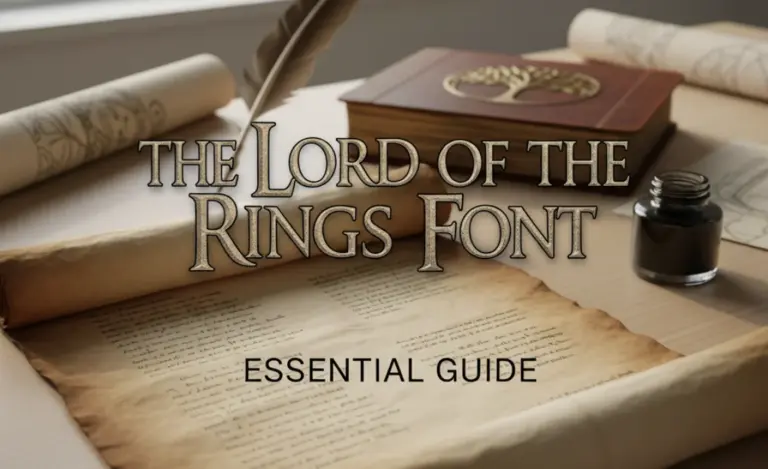Quick Summary:
An “address font” is simply the typeface you choose to display your address clearly and effectively on mail, packages, or documents. Selecting the right font ensures legibility, professionalism, and can even enhance your brand’s first impression. This guide will help you pick the perfect font for any address.
Ever stared at a pile of envelopes, wondering which font just looks right for an address? You’re not alone! Choosing a typeface for something as common as an address can feel surprisingly tricky. It needs to be clear, professional, and easy for postal services to read. Get it wrong, and your mail might look a little messy or unprofessional. But don’t worry! We’re here to demystify the world of address fonts and guide you to perfect clarity. We’ll explore what makes a font great for addresses, look at some top choices, and show you how to make your own smart decisions.
Why the Right Address Font Matters
It might seem like a small detail, but the font you use for an address plays a surprisingly important role. Think of it as the first handshake for your mail. A clear, well-chosen font shows care and attention to detail.
- Readability is Key: The primary goal is for your address to be instantly understood by both humans and machines (like mail sorting equipment). A font that’s hard to read can cause delays or errors.
- Professionalism: Especially for businesses, the font used on envelopes and shipping labels contributes to brand perception. A crisp, clean font signals a professional operation.
- Aesthetics: Even for personal correspondence, a harmonious font choice can make your mail look more polished and attractive.
- Accessibility: For some individuals, certain font styles can be easier to read than others. Clarity is always the best policy.
Understanding Font Classifications for Addresses
Before we dive into specific recommendations, let’s quickly touch upon font types. Most fonts fall into a few broad categories, and understanding these will help you make informed choices:
Serif Fonts
Serif fonts have small decorative strokes, or “feet,” at the ends of the letterforms. Think of classic fonts like Times New Roman or Garamond. These serifs can help guide the eye, making them very readable for large blocks of text. For addresses, they offer a traditional and formal feel.
Sans-Serif Fonts
Sans-serif fonts, as the name suggests, do not have these decorative strokes. They generally have a cleaner, more modern look. Examples include Arial, Helvetica, and Calibri. Sans-serif fonts are often favored for digital displays and headlines, and their simplicity makes them excellent for clear address printing.
Script and Decorative Fonts
These fonts mimic handwriting or have very stylized designs. While beautiful for invitations or logos, they are generally not suitable for addresses. Their complexity and variable strokes can significantly hinder readability, especially for automated sorting systems that rely on clear, uniform lettering.
The Best Font Categories for Addresses
When choosing a font for your address, clarity and simplicity are your best friends. This usually means sticking to two main categories:
Primarily Sans-Serif Fonts
Sans-serif fonts are often the go-to for addresses due to their clean, straightforward appearance. They excel at being legible at small sizes and under various printing conditions. Their lack of embellishments means less chance of misinterpretation.
Reliable Serif Fonts
While sans-serifs often win for pure legibility, certain serif fonts can also work beautifully. Opt for serifs that are not overly decorative or thin. A sturdy, classic serif can convey a sense of tradition and reliability. The key is to ensure the serifs don’t become too ornate or fuzzy when printed.
Top Font Recommendations for Addresses
Here are some excellent, workhorse fonts that consistently perform well when used for addresses. These are widely available and are great choices for both personal and professional use.
| Font Name | Category | Why it Works for Addresses | Best For |
|---|---|---|---|
| Helvetica | Sans-Serif | Universally recognized for its clarity and neutrality. Excellent legibility at small sizes. | Professional mail, shipping labels, business correspondence. |
| Arial | Sans-Serif | A widely available and highly legible sans-serif. Simple letterforms ensure easy recognition. | Everyday mail, general correspondence, basic shipping. |
| Open Sans | Sans-Serif | Designed for legibility across print and web. Friendly yet professional appearance. | Online shipping platforms, business mail, personal letters. |
| Lato | Sans-Serif | Warm and friendly sans-serif with clear, rounded forms. Reads well on screen and in print. | E-commerce labels, modern business mail, personal packages. |
| Roboto | Sans-Serif | A popular Google font known for its balanced structure and readability. | Digital printing, transactional mail, modern branding. |
| Times New Roman | Serif | A classic serif that offers a formal and traditional feel. Legible in its standard weight. | Formal invitations, legal documents, traditional business mail. |
| Garamond | Serif | Elegant and well-proportioned. Use a regular or semibold weight for best results. | High-end stationery, formal correspondence, invitations. |
| Source Sans Pro | Sans-Serif | Adobe’s open-source sans-serif, built for user interfaces but excellent for print. | Developer-focused businesses, technical documents, clear labeling. |
| Calibri | Sans-Serif | The default in many Microsoft applications, it’s clean, modern, and easy to read. | Default software printing, general business correspondence. |
How to Choose the Right Font for Your Needs
Selecting the perfect address font depends heavily on the context. Consider these factors:
1. Purpose and Audience
For business: Aim for professional, clear, and perhaps neutral fonts. Sans-serifs often convey modernity and efficiency, while classic serifs can suggest tradition and reliability. Whatever you choose, ensure it aligns with your brand identity. For example, a tech startup might use Roboto, while a law firm might opt for Times New Roman.
For personal use: You have a bit more flexibility. If sending out party invitations, a slightly more decorative but still readable script might work for the return address, but the recipient’s address should remain clear. For everyday mail, simple and legible is always best.
2. Legibility at Various Sizes
Your chosen font must be readable whether it’s printed large on a shipping label or small on an envelope. Fonts with distinct letter shapes (e.g., ‘I’ vs. ‘l’, ‘0’ vs. ‘O’) are crucial. Avoid fonts where the apertures (the openings in letters like ‘a’, ‘e’, ‘o’) are too small or can become filled in with ink, especially when printing at lower resolutions.
3. Printing Method and Medium
Inkjet vs. Laser: Some fonts might look sharper on laser prints than inkjet, where ink can sometimes bleed slightly, fuzzing up fine details. Generally, bolder or simpler fonts handle inkjet better.
Paper Type: Textured paper can sometimes make fonts harder to read. A robust, clear font will cut through texture better than a delicate one.
Digital Displays: If you’re displaying an address digitally (e.g., on a website), ensure the font is optimized for screen readability at various resolutions. Google Fonts offers many excellent, web-safe options like Open Sans and Lato, perfect for this. For web font guidelines, resources like Google Fonts documentation are invaluable.
4. Brand Consistency
If you’re a business owner or designer, consistency is vital. If your brand uses a specific font for its logo and marketing materials, consider using a very similar typeface (or even the same one if appropriate) for your official correspondence. This reinforces brand recognition. For instance, if your logo uses a custom sans-serif, then Arial or Helvetica for addresses maintains that clean, branded feel.
Things to Avoid in Address Fonts
Some font styles, while attractive in other contexts, can cause significant problems when used for addresses:
- Overly Thin or Light Fonts: These can be difficult to see, especially in lower-quality prints or on busy backgrounds.
- Highly Stylized Script or Cursive Fonts: While lovely for invitations, their flowing and often connected letters are a nightmare for legibility and machine reading.
- Condensed or Wide Fonts: Fonts that are excessively narrow or extremely wide can distort the spacing and make the address harder to scan quickly.
- Fonts with Ambiguous Characters: Be wary of fonts where the number ‘0’ and the letter ‘O’, or the numeral ‘1’ and the lowercase ‘l’, look too similar.
- Decorative or Novelty Fonts: Anything designed purely for effect rather than function will likely fail the readability test for addresses.
Finding and Using Address Fonts
You don’t need to be a design guru to find great fonts. Most computers come with excellent options pre-installed. For more variety, consider these resources:
- Your Operating System: Windows and macOS include a robust selection of fonts like Arial, Calibri, Times New Roman, and Georgia.
- Google Fonts: This fantastic resource (fonts.google.com) offers thousands of high-quality, free, and open-source fonts that are perfect for both web and print. Look for sans-serifs like Open Sans, Lato, Roboto, or Montserrat.
- Adobe Fonts: If you have an Adobe Creative Cloud subscription, you have access to a vast library of premium fonts.
- Professional Font Foundries: For unique branding, consider purchasing from foundries like Monotype, MyFonts, or FontShop, though these are typically for more advanced users.
How to Implement Your Chosen Font
Once you’ve selected a font, applying it is usually straightforward:
- In Word Processors/Design Software: Open your document (e.g., Microsoft Word, Adobe InDesign, Canva). Select the text box or area where you’ll type your address. Use the font dropdown menu to choose your desired typeface. Ensure you use a standard weight (like Regular or Medium) and a legible size (typically 10-12pt for envelopes, larger for labels).
- In Online Forms (Shipping, etc.): Most online shipping platforms and form builders use standard, legible fonts by default. If you have the option to customize, stick to the recommended sans-serif or simple serif choices.
- Printer Settings: Ensure your printer is set to print clearly. For example, set it to a higher quality mode if available, especially when printing on envelopes.
When to Use Different Font Styles for Addresses
Let’s break down some common scenarios and the best font types:
Scenario 1: Standard Business Mail
Goal: Professionalism, efficiency, legibility for postal services.
Best Choices: Helvetica, Arial, Open Sans, Lato, Roboto, Calibri.
Why: These are neutral, clear, and designed for readability. They ensure your address is processed quickly and looks professional.
Scenario 2: Formal Invitations or Announcements
Goal: Elegance, a touch of sophistication, while still maintaining clarity for mailing.
Best Choices (Recipient Address): Garamond (regular or semibold), Georgia, Merriweather (serifs). For the sender’s address on the back flap, a subtle script might be considered if it’s highly readable, but recipient addresses should always prioritize clarity.
Why: Serif fonts can add a touch of class. However, avoid anything too ornate. Ensuring these are printed clearly is paramount.
Scenario 3: E-commerce Shipping Labels
Goal: Maximum scanability and legibility for automated systems and fulfillment staff.
Best Choices: Open Sans, Lato, Roboto, Source Sans Pro.
Why: These are often used in digital interfaces and are optimized for clear display. Their clean lines are perfect for barcodes and addresses that need to be read quickly by machines.
Scenario 4: Personal Letters and Postcards
Goal: Clear, friendly, and perhaps a bit more personal.
Best Choices: Arial, Calibri, Open Sans, or even a very clear handwritten style if you have excellent penmanship and the postal service in your area is known for handling it well. For printed addresses, stick to clear sans-serifs.
Why: Keep it simple and easy to read. If handwriting, ensure it’s neat and distinct.
A helpful resource for understanding font licensing and best practices is the U.S. Copyright Office’s FAQ on Artificial Intelligence, which, while not directly about fonts, touches on the principles of originality and usage that apply to creative assets. For direct font usage advice, reputable font foundries often have clear licensing terms and guides.
FAQ: Your Address Font Questions Answered
Q1: What is the absolute best font for mailing addresses?
A1: While there’s no single “best,” sans-serif fonts like Arial, Helvetica, Open Sans, and Roboto are consistently excellent choices due to their superior legibility and clean design.
Q2: Can I use a script font for my address?
A2: It’s strongly discouraged, especially for the recipient’s address. Script fonts can be difficult for postal machines and even humans to read, potentially causing delivery issues. Use them only for decorative elements if absolutely necessary and ensure a clear font for the actual address.
Q3: What font size should I use for an address?
A3: For envelopes, 10-12 point is standard. For shipping labels, you might go slightly larger, around 12-14 point, to ensure maximum visibility.
Q4: Does it matter if I use a serif or sans-serif font for my address?
A4: Sans-serif fonts are generally preferred for their absolute clarity, especially in smaller sizes and for automated sorting. However, simple, well-formed serif fonts like Times New Roman can also work if readability is maintained.
Q5: Are Google Fonts safe to use for printing addresses?
A5: Yes! Google Fonts offers many high-quality, web-safe fonts like Open Sans, Lato, and Roboto that are also excellent for print. They are free to use and designed for readability.
Q6: What if my printer produces fuzzy text?
A6: Opt for simpler, slightly bolder sans-serif fonts. Ensure your printer drivers are up-to-date and select a higher print quality setting if available. Sometimes, using a different paper type can also help.
Conclusion
Choosing the right font for your address is more than just a stylistic choice; it’s about clear communication and presenting yourself effectively. By prioritizing legibility, considering your audience and the context, and avoiding overly decorative or complex typefaces, you can ensure your mail is delivered efficiently and looks its best. Stick to well-crafted sans-serifs or classic serifs, and you’ll rarely go wrong. Remember that a simple Arial or Open Sans can often be the most powerful choice. Now go forth and address with confidence!







Leave a Comment